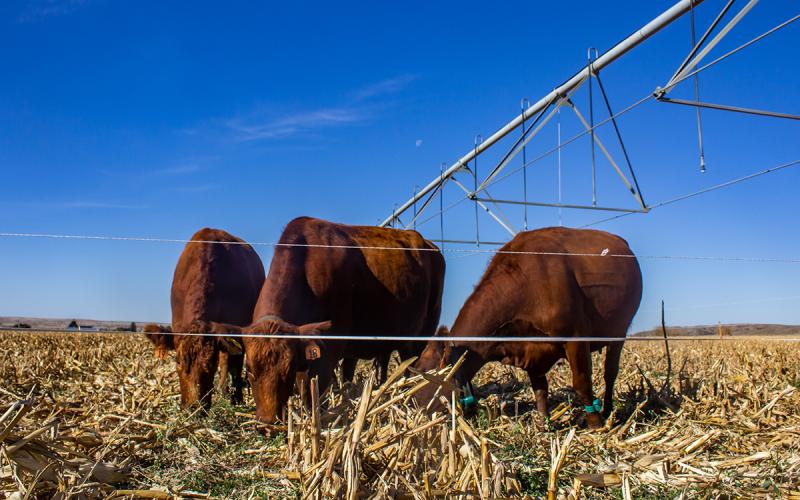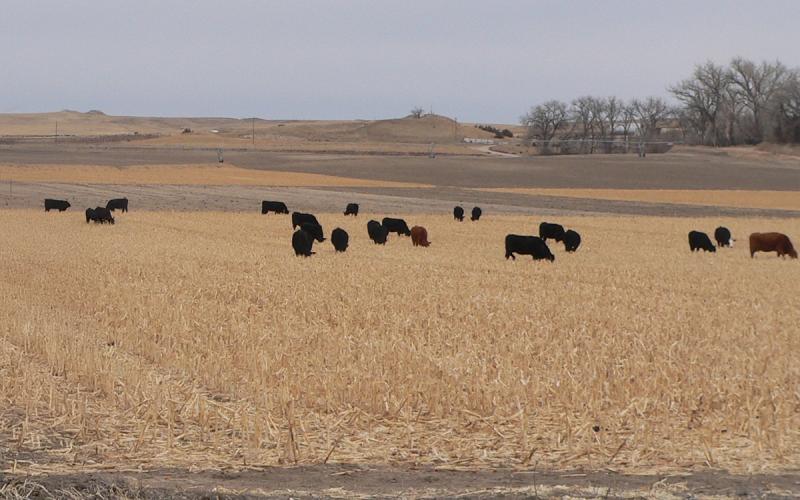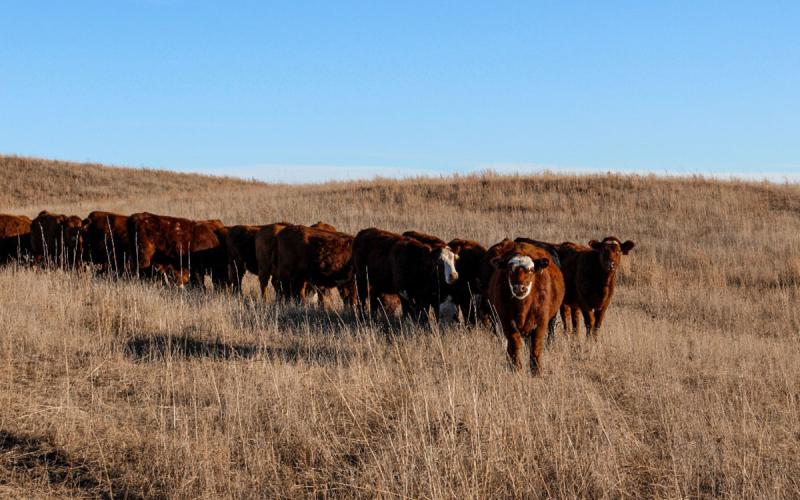Combines have been rolling for weeks, and grazing corn residue is here for some and nearing for others. Mature cows can easily utilize corn residue as an economic feedstuff in the fall during midgestation after weaning and lactation demands are removed. If stocked appropriately, grazing corn residue will not be detrimental to body condition or cropland and is a simple way to stretch the grazing season as the days get shorter and cooler. Grazing corn reside is mutually beneficial to the cropland and cattlemen, here’s why.
Clean Up Dropped Corn

Some say corn residue is not what it used to be and this is likely due to better corn varieties that do not drop as many ears off before harvest. Yet we know mother nature can cause this as well and if so, cattle can be excellent harvesters of these down ears. Cows will consume the corn ears along with the husk and leaves from corn plants which will increase cattle performance on the residue and reduce volunteer corn and extra crop inputs the following year. While grazing some ears of corn is ok, any large piles of spilled corn grain need to be cleaned up before livestock are turned out to graze. The corn grain itself is ok in small quantities but if they intake multiple pounds of corn all at once, this can cause digestive upset. It’s a good practice to drive through the field, especially where the grain cart or trucks were filled to remove these piles before cattle find them.
Manure Distribution
In addition, while cattle are consuming corn residue, they are also distributing manure throughout the fields which is beneficial to the soil and reduces labor for cattlemen who do not have haul these nutrients on to the field later. Keeping an eye on manure when cattle are grazing residue will also tell you when to move to a new field and start any supplementation. Strive for 50% grazing efficiency to properly clean the field of ears, husks and leaves, without sacrificing body condition and the need to supplement feed on fields which can increase manure concentration in certain areas.
Soil Disturbance
Grazing corn residue places livestock on acres that otherwise would be subject to equipment only. While hoof compaction is different than equipment, trailing areas are of most concern and can be limited by rotating cattle throughout field with temporary fence towards water sources. If an abundance of moisture is present, best practice is to delay grazing for a few days until soils dry. A spring corn residue grazing trial done by University of Nebraska Lincoln showed greater soybean yields after grazing corn residue at normal stocking density (NSD) compared to not grazing (NG) in Table 1. While grazing did increase surface roughness, bulk density and penetration resistance, the restriction is unlikely to be detrimental to root growth as demonstrated by no difference in plant emergence the following growing season.
| Item | NG | NSD | NG vs NSG |
|---|---|---|---|
| Surface roughness, % change | 1.6 | 9.5 | <0.01 |
| Bulk density 0-2 in at 21 days post grazing, g/cm3 | 0.85 | 1.02 | <0.01 |
| Penetration resistance 0-2 in at 21 days post grazing, MPa | 0.50 | 1.53 | <0.01 |
| Emergence, plants/ac | 102,311 | 107,340 | 0.34 |
| Soybean Yield, bu/ac | 72.9 | 75.7 | < 0.01 |
Corn Stalk Grazing Calculators are available to help cattle owners and corn growers determine stocking rates based on field size, yield, cattle size and grazing efficiency. The rule of thumb, one acre per cow per month is an easy guide to plan stocking rates using an average 1400-pound mature cow and 180-bushel corn yield (example: Stalk Grazing to Combat Volunteer Corn). Try it with your numbers using the University of Nebraska-Lincoln's Corn Stalk Grazing Calculator.
In Summary
Overall, grazing corn residue can save cattlemen time and energy allowing cattle to harvest these forages and place manure on fields themselves. Keeping an eye on the condition of cattle and ground cover is key to successfully managing this feeding strategy for best animal and subsequent crop performance. Eventually the weather conditions will make grazing difficult, and cattle will come off to be fed in other ways. Thus, utilization of corn residue is a great way to stretch the grazing season while farmer feeders finish up field work before switching over to the feed tractor in the winter. For additional information on grazing corn residue, listen to the Cattle HQ podcast, Make Grazing Simple Again. You can also contact an SDSU Extension expert with any questions on setting up a successful corn residue grazing season.
Resources
- Make Grazing Simple Again – Winter corn residue grazing, SDSU Extension.
- Livestock Decision Tools - Corn Stalk Grazing Calculator, University of Nebraska-Lincoln Center for Agricultural Profitability.
- Impact of Spring Corn Residue Grazing on Soil Physical Properties and Crop Yield, Morgan T. Grabau, J. C. MacDonald et al.


